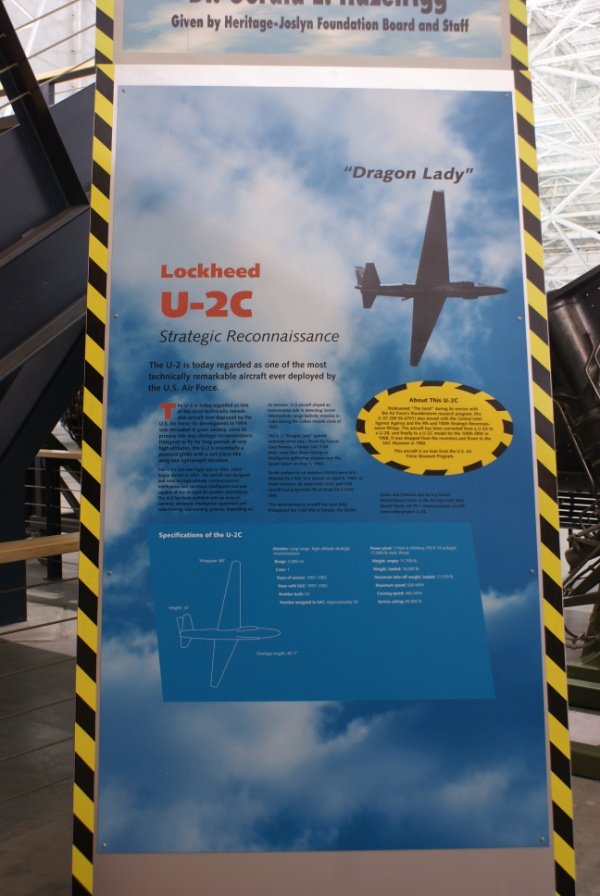| Prev |
heroicrelics.org Strategic Air Command & Aerospace Museum Site Index U-2 Dragon Lady Gallery |
Next |
dsc44735.jpg
The sign accompanying the aircraft. It reads
"Dragon lady"
Lockheed
U-2C
Strategic ReconnaissanceThe U-2 is today regarded as one of the most technically remarkable aircraft ever deployed by the U.S. Air Force.
The U-2 is today regarded as one of the most technically remarkable aircraft ever deployed by the U.S. Air Force. Its development in 1954 was shrouded in great secrecy, since its primary role was strategic reconnaissance. Designed to fly for long periods at very high altitudes, the U-2 is essentially a powered glider with a sail-plane-like wing and lightweight structure.
The U-2's first test flight was in 1955, and it began service in 1957. The aircraft was designed and used for high-altitude communications intelligence and electronic intelligence and was capable of day or night all-weather surveillance. The U-2 has been outfitted with an array of cameras, electronic intelligence equipment and radar-homing and warning systems, depending on its mission. U-2 aircraft played an instrumental role in detecting Soviet intermediate-range ballistic missiles in Cuba during the Cuban missile crisis of 1962.
The U-2 "Dragon Lady" gained notoriety when one -- flown by Francis Gary Powers, a former SAC F-84 pilot -- was shot down during an intelligence gathering mission over the Soviet Union on May 1, 1960.
Soviet surface-to-air missiles (SAMs) were first detected by a SAC U-2 aircraft on April 5, 1965, in North Vietnam. By year's end USAF and USN aircraft had pinpointed 56 of these SA-2 SAM sites.
This reconnaissance aircraft has seen duty throughout the Cold War in Europe, the Soviet Union and Vietnam and during Desert Shield/Desert Storm in the Persian Gulf. After Desert Storm, all TR-1 reconnaissance aircraft were redesignated U-2R.
About This U-2C
Nicknamed "The Saint" during its service with the Air Force's thunderstorm research program, this U-2C (SN 56-6701) also served with the Central Intelligence Agency and the 9th and 100th Strategic Reconnaissance Wings. The aircraft has been converted from a U-2A to a U-2B, and finally to a U-2C model for the 100th SRW in 1968. It was dropped from the inventory and flown to the SAC Museum in 1982.
This aircraft is on loan from the U.S. Air Force Museum Program.
Specifications of the U-2C
Mission: Long-range, high-altitude strategic reconnaissance
Range: 3,000 mi
Crew: 1
Years of service: 1957-1992
Years with SAC: 1957-1992
Number built: 53
Number assigned to SAC: Approximately 35
Power Plant: 1 Pratt & Whitney J75-P-13 turbojet, 17,000-lb static thrust
Weight, empty: 11,700 lb
Weight, loaded: 16,000 lb
Maximum take-off weight, loaded: 17,270 lb
Maximum speed: 528 MPH
Cruising speed: 460 MPH
Service ceiling: 85,000 ft
Wingspan: 80'
Height: 13'
Fuselage length: 49' 7"

| Time picture taken | Sun Jul 27 15:15:02 2008 |
| Location picture taken |
Hangar A/Upper Walkway Strategic Air & Space Museum Ashland, NE |
| Prev |
heroicrelics.org Strategic Air Command & Aerospace Museum Site Index U-2 Dragon Lady Gallery |
Next |